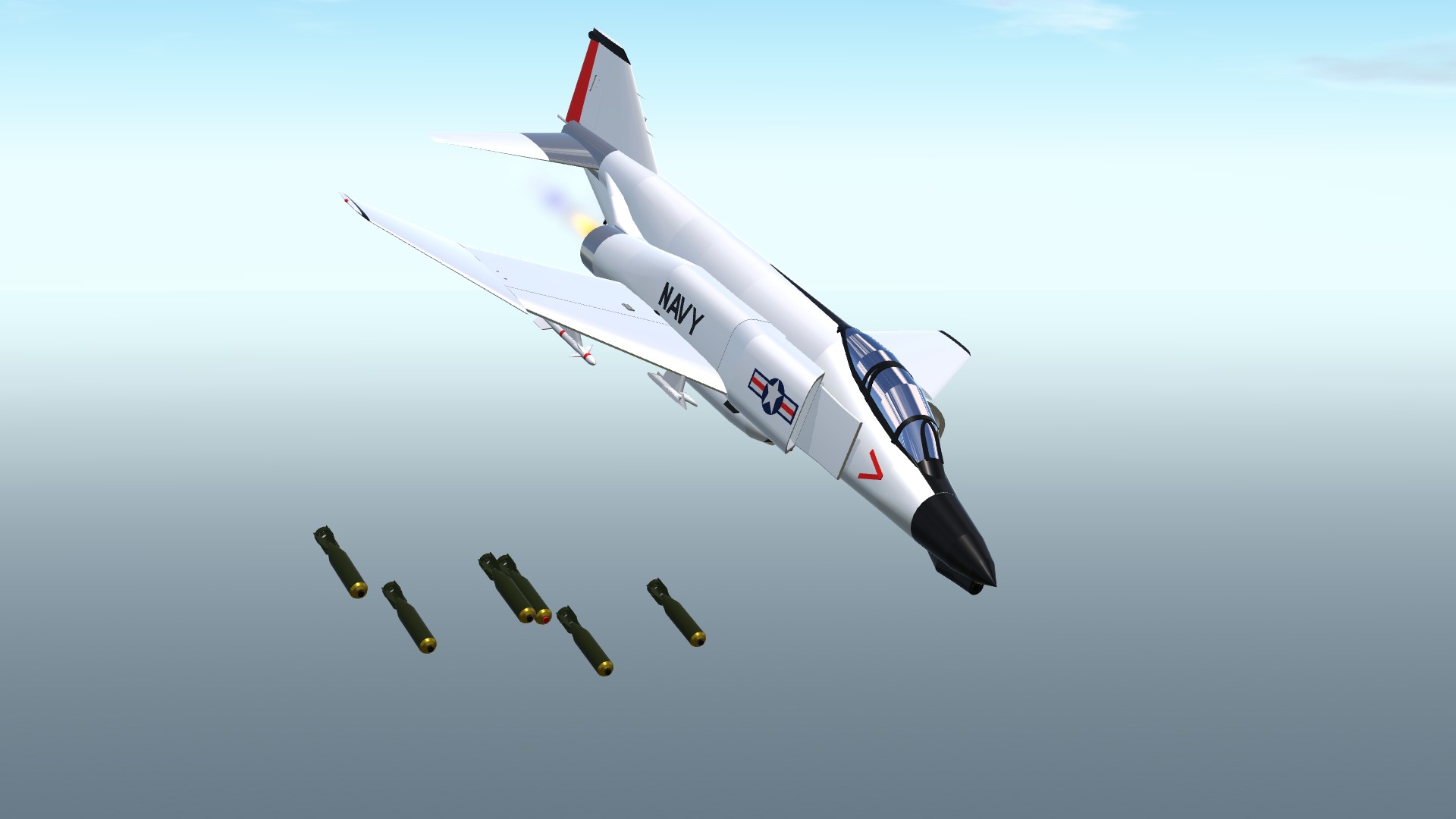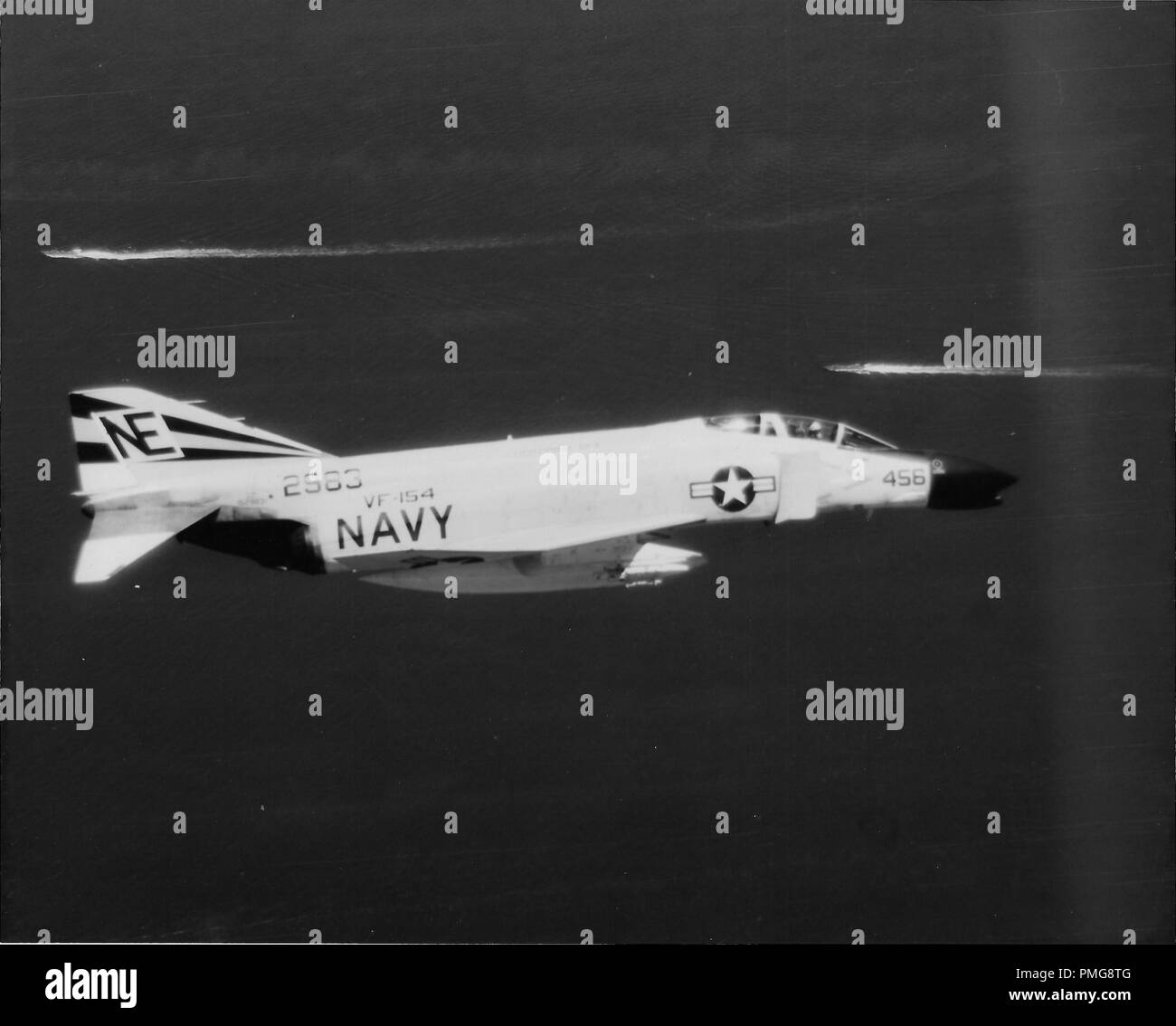Navy F4 Phantom - The remarkable career of the McDonnell Douglas F-4 Phantom II began exactly 60 years ago, when the first example was delivered to the US Navy to begin training pilots in the "miracle of the folded wings". That delivery launched a monumental race for the classic Cold War fighter in the hands of three US services and a host of foreign operators. The curtain on the Phantom's US military service has just fallen in 2016, an event that
Fighter Squadron 121 (VF-121), the "Pacemakers", had the honor of introducing the first Phantoms into military service anywhere in the world. On December 30, 1960, VF-121 took control of its first F4H, as the Phantom was then known, the fighter was delivered by McDonnell Aircraft Corporation in St. Louis, Missouri, to the squadron home at Naval Air Station Miramar, California. It wasn't until September 1962 that the Phantom received its more familiar F-4 designation under the tri-service naming system.
Navy F4 Phantom

The VF-121 "Pacemakers" eventually replaced their early production Phantoms with the much improved F-4J model, an example of which returned to Miramar in 1978, US Navy
Men Who Flew The F 4 Phantom
These first VF-121 Phantoms were the F4H-1F model, known as the F-4A from 1962 onwards, of which only 45 were produced. That's a relative drop in the ocean compared to the 5,195 F-4s that were built, not just in the United States but also in Japan, where the type has just been withdrawn from first service. Meanwhile, in Greece, Iran, Turkey and South Korea, the Phantom is still operating.
As the first recipient of a major new all-weather fighter, the VF-121 "Pacemakers" role was tasked with training pilots and Radar Intercept Officers (RIOs) for the Phantom, as the West Coast Fleet Replacement Air Group (RAG). , or a school for that matter. Since the Phantom added the RIO, the training effort has increased accordingly - a second crew member hadn't been in the cockpit of a US Navy fighter since the subsonic F3D Skyknight a decade earlier. RIO's job was to operate the Phantom's sophisticated Westinghouse radar, part of a space-age avionics suite that also boasted a Raytheon missile guidance system, an advanced navigation suite, and an analog air data computer.
An idea of the caliber of the newly minted Phantom Airmen coming out of VF-121 was given by Commander Charles "Pete" Conrad and Lieutenant Richard F. "Dick" Gordon, who transitioned from training with the "Pacemakers" to serving on the Apollo lunar mission. 12.
Another McDonnell product, the F3H Demon was still flying the VF-121 "Pacemakers" when its first Phantoms began to arrive., US Navy
File:phantom Fg1 892 Sqn On Hms Ark Royal (r09) 1972.jpg
On the East Coast, the RAG equivalent was VF-101, the "Grim Reapers", at Naval Air Station Oceana, Virginia, whose detachment actually broke away and moved to Miramar to advance to VF-121.
Aside from the two crew members, the Phantom was already a vast improvement over the F3H Demon and F11F Tiger that the "Pacemakers" had previously flown. It was significantly larger and more powerful - with two engines instead of one. Despite the lack of the planned J79-GE-8 turbojets, even the interim GE-2 series engines on the F4H-1F each provided over 16,000 pounds of afterburning thrust, capable of propelling it to speeds in excess of Mach two.
In terms of armament, the Phantom was designed without a weapon, relying on guided missiles, an omission that would have to be corrected after the jet was deployed in close combat in the Vietnam War. The same conflict led to the emergence of the F-4 as a true multirole platform, perhaps the first of its kind, carrying a wider range of weapons than any of its contemporaries.

However, the early days of Phantom Flight were dangerous. The first prototype of the F4H-1 crashed at Edwards Air Force Base, California, in October 1959 during a test flight for an attempt to set a world speed record, claiming the life of test pilot Gerald "Zeke" Huelsbeck.
That Time An F 4 Phantom Ii Outran An F/a 18 Hornet And Zoomed At 82,125 Feet Per Minute
F4H-1 Phantom II Bureau #142259 was the aircraft lost in an October 1959 crash that killed test pilot Gerald “Zeke” Huelsbeck., San Diego Air and Space Museum
Then, in May 1961, Commander J.L. Felsman was killed while performing a low-speed run in an early production F4H-1. This accident, as well as another at Patuxent River, Maryland, both bore the hallmarks of a pilot-induced oscillation, or PIO, when excessive pilot input to the flight controls caused the aircraft to vibrate, effectively collapsing.
Among the first in the VF-121 to get their hands on the Navy's new Phantom was Commander Wilbur Norton, who addressed the jet's problems:
The Phantom itself was incredibly stable. In fact, the stability of the design was a notable improvement over what we were flying at the time. But those who were stubborn would control the Ghost too much or correct him if something went wrong. The plane would then wobble like crazy. The best way to get rid of this high vibration problem is to take your hands off the controls and just watch. At high altitudes, you can easily recover. At low altitude, IOP is instant death.
Navy Spec 1959 Mcdonnell F 4 Phantom Is One Of A Kind, Selling For $3.25 Million
Ultimately, the PIO didn't reflect any inherent flaws in the Phantom's basic design, but had more to do with pilots learning to adapt to the complexities of this extraordinarily powerful machine. The RAGs' training curriculum was adapted accordingly, with an emphasis on lightly touching the controls, even when launching a jet in simulated combat.
An F-4G camouflaged from VF-121 at Miramar in 1966. Only 12 of these Phantoms were converted from the F-4B, with the data link system and other changes., US Navy
Past experience with the Phantom shows that even raising a purebred dog has its difficulties, with aircraft designs and lives lost in high-profile accidents. In February 1962, however, the F4H-1 was ready to go to sea for the first time in an operational capacity, when VF-102 embarked on the USS Enterprise (CVAN-65). The world's most advanced aircraft carrier - then on her cruise - made a fitting home for the Phantom, which would soon establish itself as the Navy's most prominent fighter before embarking on an equally successful career on land. US Navy McDonnell F-4N Phantom II (BuNo 151491) of fighter squadron VF-161 "Chargers" in flight. 151491 was assigned to VF-161, Carrier Air Wing 5 (CVW-5), on the aircraft carrier USS Midway (CV-41) from 1973 to 1977. Retired to MASDC as 8F0077 on 3 November 1977.

What makes the F-4 Phantom special? In the 1950s, McDonnell Aircraft began development of what has been described as one of the greatest fighter jets of the post-World War II era. Originally developed as an attack aircraft with four 20mm guns, the F-4 Phantom has evolved into an advanced all-weather but unarmed interceptor equipped with advanced radar and missile weaponry. Just thirty-one months after its first flight, it was accepted by the US Navy in 1961 - making it the fastest, longest-range, longest-range fighter.
Why F 4 Phantom Ii Fighter Is Such A Legendary Plane
Shortly thereafter, the aircraft was accepted by the United States Marine Corps and United States Air Force. The long-range, twin-engine, two-seat tandem supersonic jet interceptor and all-weather fighter-bomber proved ideal for military needs during the Cold War.
It was well armed and could carry over 18,000 pounds (8,400 kg) of weapons in nine external mounts, including air-to-air missiles, air-to-surface missiles and several bombs. Later models also included the M61 Vulcan rotary cannon to give the warbird a little more firepower. The aircraft was also fitted with a Westinghouse APQ-72 radar, an infrared detector in a small fairing under the nose.
The aircraft had several colorful nicknames, including "The Council", "The Flying Brick", "The Ugly Double", "The Rhino", and "The Big Iron Sleigh". However, it was officially named the Phantom II on July 3, 1959, during a ceremony held at the McDonnell factory in St. Louis. Louis, Mo., to commemorate the company's 20th anniversary
Capable of traveling at twice the speed of sound – Mach 2.2 – the McDonnell Douglas F-4 Phantom II set sixteen records for speed, altitude and time taken to climb; setting a world altitude record of 98,556 feet in 1959 and a speed record of 1,604 mph on a 15-mile loop in 1961.
Us Navy F 4 Phantom Ii Units Of The Vietnam War 1964 68: Davies, Peter E., Laurier, Jim: 9781472814517: Books
It was the only aircraft used by both US military demonstration teams: the Navy Blue Angels and the Air Force Thunderbirds; who flew the Phantom II from 1969 to 1973.
Mockup of the McDonnell F3H-G/H proposed by the US Navy. In 1953, McDonnell Aircraft began work on overhauling its F3H Demon fighter, seeking expanded capabilities and better performance. The company developed several designs, including a variant powered by a Wright J67 engine and variants powered by either two Wright J65 engines or two General Electric J79 engines. The version with the J79 engine promised a top speed of Mach 1.97. On September 19, 1953, McDonnell approached the US Navy with a proposal for the Super Demon. Uniquely, the aircraft was to be modular - it could be fitted with single or double-seat noses for different missions, with different nose cones to accommodate the radar, camera, four 20mm cannons,
Sig p365 tulster holster, sig p365 iwb holster, sig holsters p365, sig p365 sas holster, sig p365 xl holster, sig p365 hybrid holster, appendix holster sig p365, safariland holster sig p365, sig p365 belt holster, sig p365 holster, sig p365 purse holster, sig sauer p365 holster
0 Comments